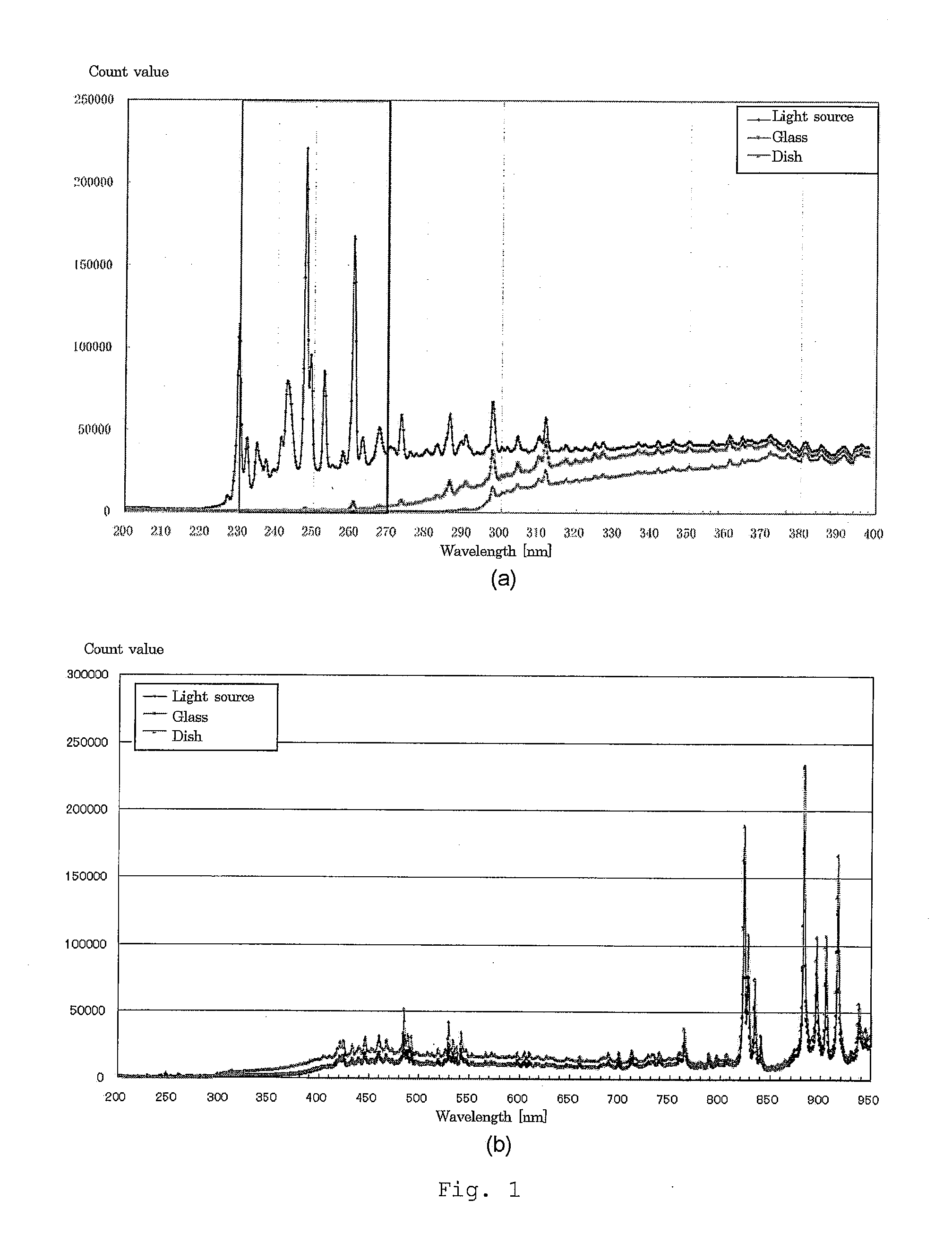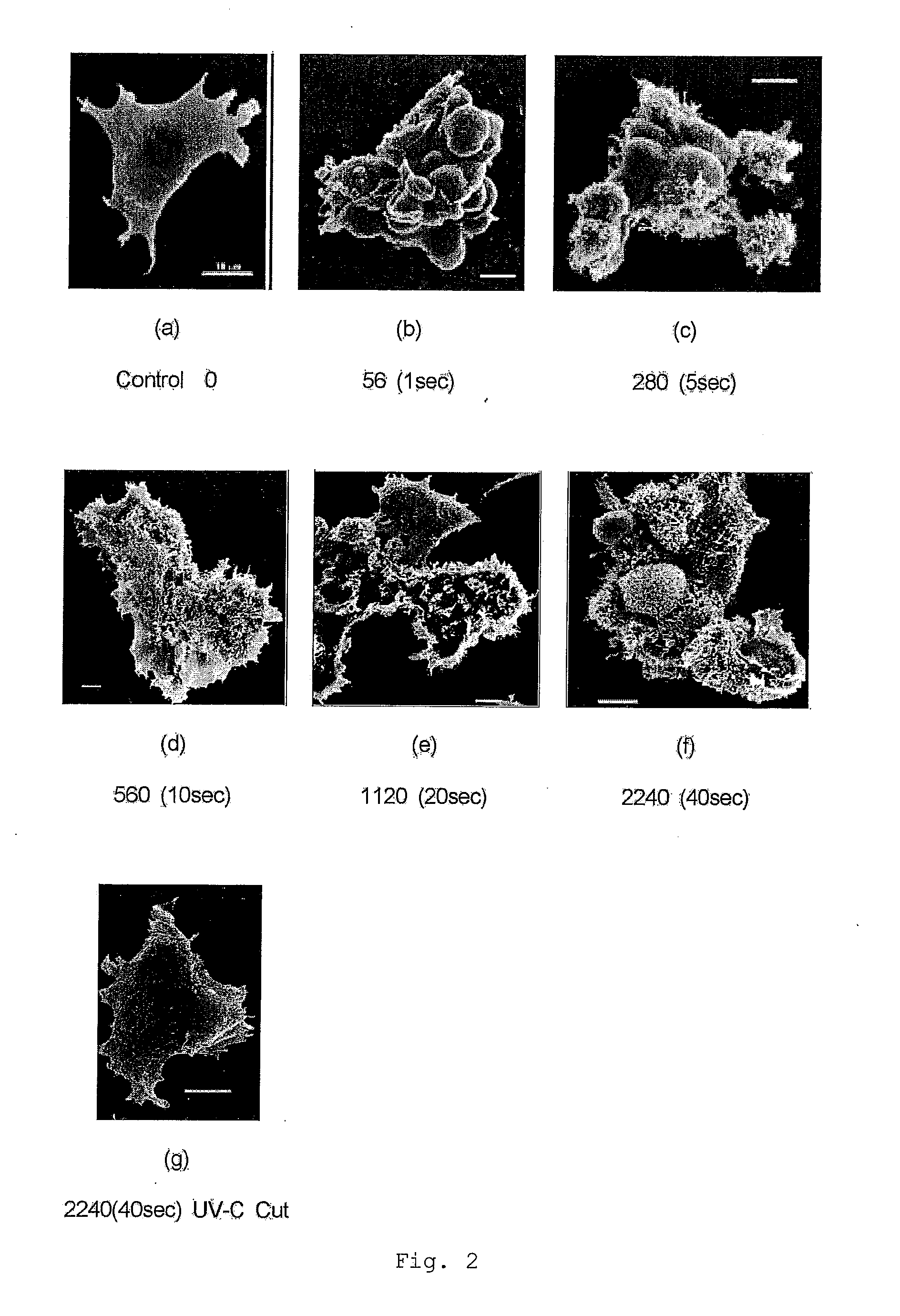Method for Selectively Damaging and Killing Tumor Cells and Apparatus Therefor
a tumor cell and selective damage technology, applied in the field of selective damage and tumor cell killing methods and apparatuses, can solve the problems of difficult operation, do damage to normal tissues in addition to tumor cells, and the applicability of pulse light using xenon flash lamps
- Summary
- Abstract
- Description
- Claims
- Application Information
AI Technical Summary
Benefits of technology
Problems solved by technology
Method used
Image
Examples
example 1
Material / Method
[0047]UV pulse flash light source (using a xenon flash lamp): BHX-200 (COMET Corp.)
Confocal laser scan microscope: LSM510-META (Carl Zeiss Microlmaging, Jena Germany)
[0048]1. MCF-7 (cell line originated from human breast cancer)
[0049]2. BT474 (cell line originated from human breast cancer)
[0050]3. Hella (cell line originated from human cervical cancer)
Non-Tumor Cells:
[0051]1. Cos 7 (cell line originated from African green monkey kidney)
[0052]2. MDCK (cell line originated from canine kidney uriniferous tubule epithelial cell)
[0053]At first, utilizing cell intrinsic fluorescence of each cell, morphology information of each cell was obtained. Then, to each cell, MBL Azami-Green (phmAG1-MC1) DNA was transfected using Lipfectamine-2000 (Invitrogen), and the fluorescence was observed. Under the environment of 5% CO2 and 37° C., three-dimensional images were obtained using LSM510-META. Thereafter, BHX-200 was set at a position of 8 cm immediately above the cells,...
example 2
Tumor Cell Lines
[0059]4. Human leukemia cell line MOLT / S
[0060]5. Human leukemia cell line MOLT / TMQ 200 (line 200-time resistant to trimetrexate (TMQ) anticarcinogenic agents)
[0061]6. Human leukemia cell line K562 / S1
[0062]7. Human leukemia cell line K562 / S2
[0063]8. Human leukemia cell line K562 / ARA-C (line resistant to Cytarabine anticarcinogenic agent)
Method
[0064]To each cell described above, propidium iodide (PI) was added. At first, utilizing intrinsic fluorescence of each cell, morphology information of each cell was obtained, similarly to Example 1. Then, under the environment of 5% CO2 and 37° C., three-dimensional images were obtained using LSM510-META. Thereafter, BHX-200 was set at a position of 8 cm immediately above the cells, and the cells were irradiated with a UV pulse flash (the frequency of irradiation: 0, 14, 56, 560, 2240 times). Thereafter, three-dimensional images were obtained again. The life and death of the cells was observed based on PI reaction. After the irr...
example 3
Tumor Cell Lines
[0067]9. Human fibrosarcoma cell line HT-1080
[0068]10. Human prostate cancer cell line DU145
[0069]11. Human prostate cancer cell line PC3
[0070]12. Human malignant chorioepithelioma cell line BeWo
Method
[0071]To each cell described above, propidium iodide (PI) was added. At first, utilizing intrinsic fluorescence of each cell, morphology information of each cell was obtained, similarly to Example 1. Then, under the environment of 5% CO2 and 37° C., three-dimensional images were obtained using LSM510-META. Thereafter, BHX-200 was set at a position of 8 cm immediately above the cells, and the cells were irradiated with a UV pulse flash (the frequency of irradiation: 0, 14, 56, 560, 2240 times). Thereafter, three-dimensional images were obtained again. The life and death of the cells was observed based on PI reaction. After the irradiation with the UV pulse flash, the cells were cultured continuously for 24 hours. The cells were observed again to determine a viability. T...
PUM
| Property | Measurement | Unit |
|---|---|---|
| distance | aaaaa | aaaaa |
| time | aaaaa | aaaaa |
| thickness | aaaaa | aaaaa |
Abstract
Description
Claims
Application Information
 Login to View More
Login to View More - R&D
- Intellectual Property
- Life Sciences
- Materials
- Tech Scout
- Unparalleled Data Quality
- Higher Quality Content
- 60% Fewer Hallucinations
Browse by: Latest US Patents, China's latest patents, Technical Efficacy Thesaurus, Application Domain, Technology Topic, Popular Technical Reports.
© 2025 PatSnap. All rights reserved.Legal|Privacy policy|Modern Slavery Act Transparency Statement|Sitemap|About US| Contact US: help@patsnap.com



